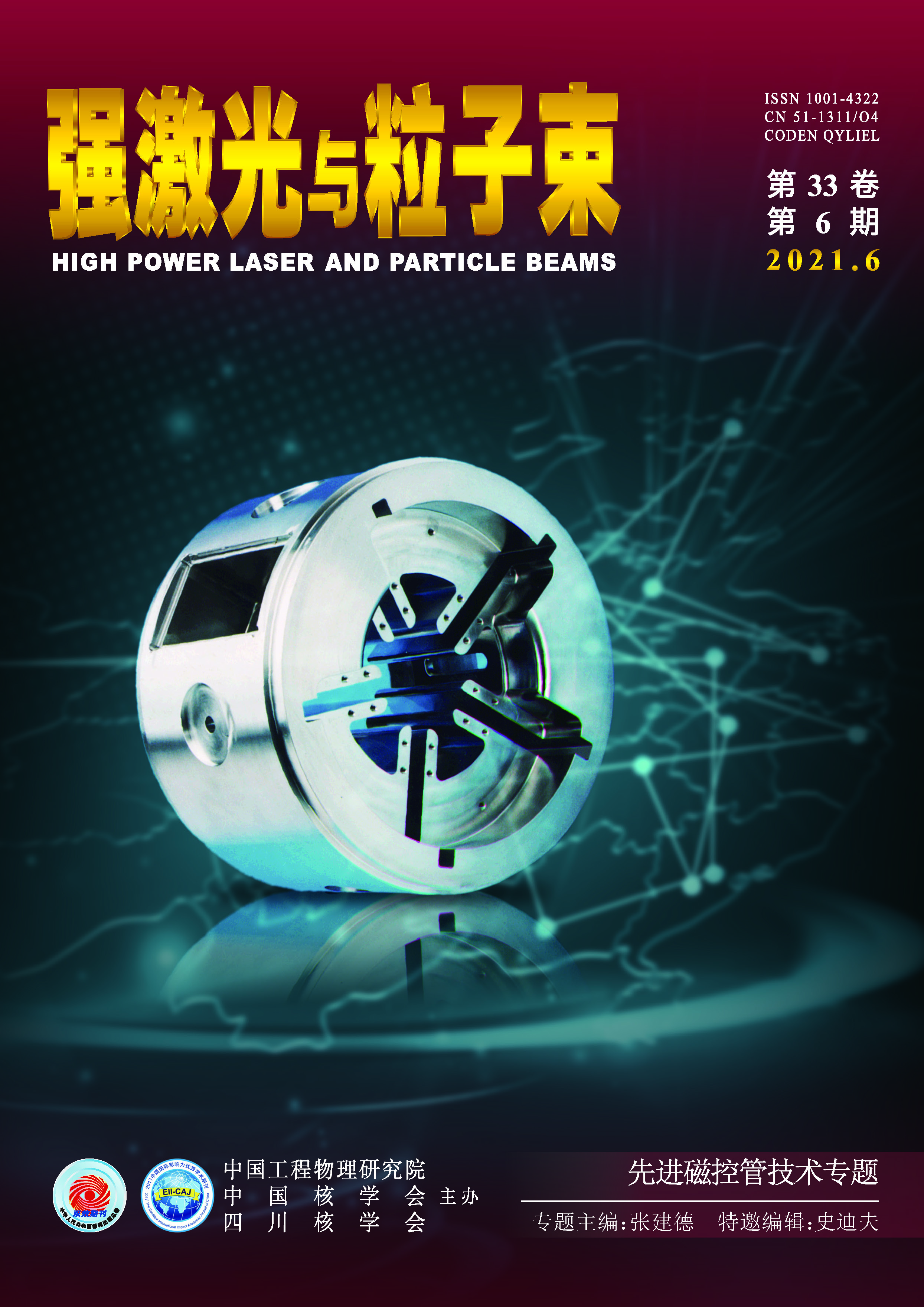2021 Vol. 33, No. 7
Based on our findings published in 2016, we have carried out further studies on the performance improvements of the relativistic magnetron using all-cavity output and semi-transparent cathode. By modifying the semi-transparent cathode, that is, rotat...
To achieve long-term steady operation of high power microwave source, relativistic magnetron (RM) with diffraction output has been investigated for long-term operation. Experimental investigation was carried out based on an L-band relativistic magnet...
A relativistic magnetron with online switchable rotation direction of a circularly polarized TE11 output mode is proposed. In the device, the same cavity magnetron is adopted as the beam-wave interaction structure, the all-cavity extraction structure...
The commutation phenomena produced by anode outgassing ionization and secondary electron emission are a possible factor to limit the performance of the transparent cathode relativistic magnetron with all cavity axial extraction (TCMAC). In this paper...
As the mode competition of magnetrons becomes more intense, to better study the mode of magnetron, a mode decomposition method is proposed in this paper, and the A6 relativistic magnetron is selected as the research object. The results of mode decomp...
An L-band relativistic magnetron with cathode endcaps is presented and investigated numerically. Cathode endcaps are introduced in the relativistic magnetron to decrease the axial leakage current and enhance the power efficiency. Three-dimensional pa...
It is confirmed that transparent cathode technology has a significant influence on oscillation start-up process in relativistic magnetron, while the fast start-up mechanism is under further evaluation. Electromagnetic field distribution and charged p...
We demonstrated a novel fiber laser system with oscillating-amplifying integrated configuration and a 5 kW output power was achieved experimentally for the first time with optical-to-optical efficiency of 80%. The reliability and the boot order of th...
The SiO2 antireflective (AR) coating was prepared by sol-gel method and then modified by plasma combined with hexamethyldisilazane (HMDS). The effects of treatment on the surface morphology, microstructure, optical properties, and laser induced damag...
Broadband laser can effectively reduce the nonlinear effect in the process of laser plasma interaction. This paper proposes a noncollinear matching broadband third-harmonic generation based on angular dispersion, which uses the noncollinear sum frequ...
According to the demand of high power semiconductor laser for high power, low ripple and high reliability constant current driver, a constant current power supply based on four BUCK modules in parallel is designed. The maximum output power is 37.5 kW...
The traditional method of measuring temporal coherence is realized by means of mechanical scanning. However, this method can not be used for single-shot measurement, and the measurement error is larger for broadband light. In this paper, a new method...
To study the starting characteristics of the variable cross-section supersonic-supersonic ejector with different structural and flow parameters, the two-dimensional Reynolds averaged Naiver-Stokes equations were employed to examine the different tota...
Large-scale space simulation of high field intensity electromagnetic environment is difficult to test radiation effects, and there are gaps in the application of existing BCI (bulk current injection) technology to nonlinear system tests. The research...
Starting from reducing the peak power and average power on the collector surface of a gyrotron oscillator, we have designed a magnetic field scanning system composed of 12 transverse elliptical AC coils and 2 longitudinal DC coils. According to the d...
In this work, a 2.5-dimensional discontinuous Galerkin time-domain(2.5D-DGTD) method with perfectly matched layer is proposed as a flexible tool to solve accurately electromagnetic problems in which media are homogeneous in one direction. Two numeric...
Computed tomography is a major technique for nondestructive detection of internal defects of dense materials and large-size devices. It is widely used in material science, railway, aerospace, national defense, military industry and other industries. ...
Power supply prototype in High Intensity heavy ion Accelerator Facility-Booster Ring (HIAF-BRing) adopts the scheme of full energy and fast cycle storage pulse power supply topology. Its multi modules are connected in series and parallel pattern, and...
In the construction of Hefei advanced light facility (HALF), vacuum components of superconducting materials are widely used, especially superconducting radio frequency cavity. The superconducting cavity with the characteristics of high accelerating g...
Post mortem system is one of the key analysis tools for the accelerators to achieve high reliability and high availability. The precise time correlated data with high resolution that archived during the failure process is the base for the post mortem...
Based on conservation equation of energy, channel characteristics of the cylindrical geometry of the plasma were described under different conductivity models. The variation of the channel radius, temperature, resistance, current and dissipated energ...
In the process of depressurization during severe accidents for the second generation nuclear power plant, high temperature fluid flowing through the severe accident depressurization valves may cause deformation of the valve body or even cause the val...
The size and space of droplets produced by the droplet generator affect the radiation and evaporation characteristics of the droplet layer, and the controllability of the size and space of the droplets deserves special attention. According to Weber’s...
To realize effective recognition of far-region nuclear electromagnetic pulse and lightning electromagnetic pulse, a recognition algorithm based on Hilbert-Huang transform (HHT) and least squares support vector machine was proposed. According to the d...




 Email alert
Email alert RSS
RSS

